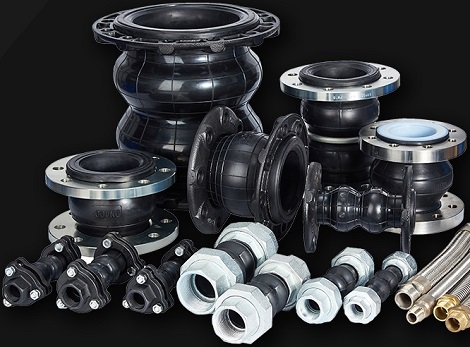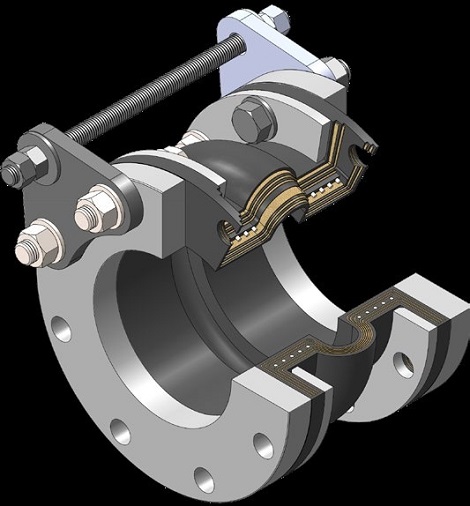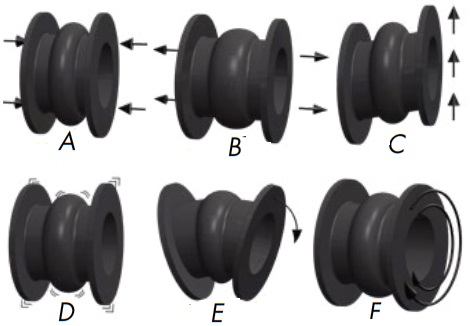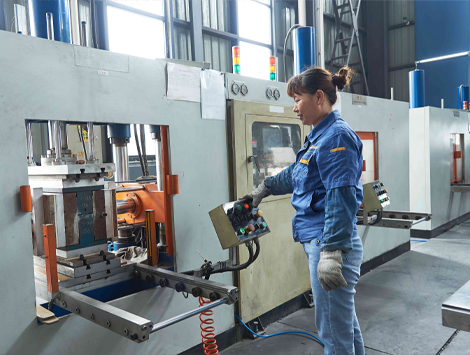Categories
- Pipe & Tube (18)
- Flange & Fitting (97)
- Fastener & Gasket (12)
- Valve & Pump (18)
- Base Material (11)
- Equipment (8)
- Application (30)
- Technical (110)
A rubber expansion joint is an arch-type flexible non-metallic connector fabricated from natural or synthetic rubber and fabrics, usually with metal reinforcements, to isolate vibration and noise and provide stress relief in piping systems caused by thermal changes, mechanical vibration and other system movements. Generally, it shall be designed & fabricated in accordance with ASTM F1123 and “Technical Handbook on Rubber Expansion Joints and Flexible Pipe Connectors”, or in accordance with special customer requirements. Besides, the Chinese standard HG/T 2289 Flexible Rubber Joints sometimes may apply.

Various rubber expansion joints for piping systems.
Rubber expansion joints provide flexibility and concurrent movements, isolation of vibration and noise, resistance to corrosion, abrasion and erosion in various piping systems. They are widely used in process piping systems, urban heating & air conditioning systems, water supply systems, sewage treatment, food industry, ship building industry, power generation, as well as pharmaceutical industry.
A rubber expansion joint generally consists of inner tube, cover and carcass. The inner tube shall be made of natural rubber, synthetic rubber, or blend of synthetic rubber. It is a seamless protective, leak-proof lining that extends through the bore to the outside edges of the joint. Since the inner tube is in direct contact with the flowing media, it shall be designed to cover service conditions for chemical, petroleum, sewage, gaseous and abrasive materials. The purpose of the tube is to eliminate the possibility of the materials being handled penetrating the carcass and weakening the fabric. The cover is the exterior surface of the joint that is formed from natural or synthetic rubber. The prime function of the cover is to protect the carcass from outside damage caused by atmospheric chemicals, oils, air, sunlight, vapor, etc. The carcass or body of the rubber expansion joint is the flexible and supporting member between the tube and cover. It is the structural framework of the joint and is made from multiple plies woven fabric or tire cord impregnated with synthetic rubber. Steel wires or solid metal rings are often embedded in the carcass to provide additional reinforcement to the body fabric.

The 3-dimensional model of a spool arch type rubber expansion joint. The sectional view of the inner tube, carcass and cover.
Miscellaneous design patterns of rubber expansion joints are available: (1) Integral Rubber Flanges – The end connection flanges of the joint are integrally formed as a part of the elastomeric bellows. It is also called “spool arch type rubber expansion joint”. (2) Floating Metallic Flanges – The metal flanges shall have a groove to accept the molded bead in the body at each end of the expansion joint bellows. (3) Spherical Type – Long radius arch, either single sphere or twin sphere, to provide better movement capability and strength. (4) Control Units – Tie rods or control rods are provided to minimize possible damage to the expansion joint caused by excessive motion of the piping system. (5) Custom Designs – rectangular flange connection, threaded union connection, tapered reducer type, no-arch U type, hinged type, gimbal type, sleeve type, PTFE lined type.
| Specification of Rubber Expansion Joints | ||
|---|---|---|
| Single Sphere | Twin Sphere | Union Spherical |
| Spool Arch | Tie Rods | Special Design |
| Flange Drilling | Installation & Maintenance | Testing & Inspection |
As illustrated in the picture below, rubber expansion joints are primarily designed to absorb and compensate for various movements and vibration in a piping systems: (A) Axial Compression – The dimensional reduction or shortening of in face-to-face parallel length of the joint measured along the longitudinal axis. (B) Axial Elongation – The dimensional increase or lengthening of face-to-face parallel length of the joint measured along the longitudinal axis. (C) Lateral Movement – The movement of relating displacement of the two ends of the joint perpendicular to its longitudinal axis. (D) Vibration – Mechanical oscillations in the piping system, usually in high frequency. (E) Angular Movement – The angular displacement of the longitudinal axis of the joint from its initial straight line position, measured in angle degrees. One half of the joint has axial elongation and the other has axial compression. (F) Torsional Movement – One end of the expansion joint is twisted around the longitudinal axis while the other end is held fixed.

The function of a rubber expansion joint and the absorption of various movements: A-axial compression, B-axial elongation, C-lateral or transverse movement, D-vibration, E-angular movement, F-torsional movement.
The rubber expansion joint also exhibits excellent noise absorption characteristics. Its relative impedance to sound based on rubber is 1.0, while the relative impedance based on steel is 500. The low relative impedance number corresponds to low sound transmission. The joint can significantly limit or interrupt the transmission of a sound/ noise from operating equipment to the piping system.
The material selection shall be determined by service conditions. Generally, it includes the material selection for the elastomeric body as well as the end connector (if not integrally formed). As introduced previously in this article, the elastomeric body consists of inner tube, cover and carcass. Both the tube and cover shall be made from a series of elastomers including pure gum rubber, natural rubber, neoprene, butyl, chlorobutyl, styrene-butadiene, CSM, PTFE, nitrile, hypalon, EPDM, FKM, etc. The carcass made of woven fabric or tire cord shall be selected from nylon, polyester, fiberglass, or aramid. For the floating end connector, if it is flange, generally the material shall be carbon steel (ASTM A105) or stainless steel (SS304 or SS316); if it is threaded union, the material shall be malleable cast iron.

The vulcanization of the rubber expansion joint body.
The manufacture or fabrication of a rubber expansion joint includes the following salient processes: (1) Compounding – Add necessary ingredients to rubber to form the elastomer that can meet service requirements. (2) Mixing – It involves the mastication process and incorporation of additives. The rubber will become soft and tacky, and articles could be built up from multiple pieces of the masticated rubber. (3) Forming of the joint body on a die mold. (4) Vulcanization of the rubber joint to give the material its elastic recovery behaviour. (5) Assembly – Install the rubber joint with end connector as well as control units. (6) Inspection & Testing. (7) Cleaning & Packaging.
Shijiazhuang Metalsin supplies superb-quality rubber expansion joints through several long-term partners who have been in the manufacturing industry for more than 15 days. All our joints are designed and manufactured in compliance with national and international regulatory standards. The manufacturers are distributed in China’s several industrial centers: Gongyi, Henan Province; Cangzhou, Hebei Province; and Nantong, Jiangsu Province. The factories work in compliance with ISO 9001:2015 and most series of the rubber expansion joints produced are subject to the European Pressure Equipment Directive and are therefore CE-compliant. Routine inspection & special tests by major third-party authorities such as TUV, BV, Lloyds, DNV, ABS, CCS, SGS can be arranged upon client’s request. We are always committed to provide cost-effective rubber expansion joints that are maintenance-free, highly reliable in service and extremely durable.
